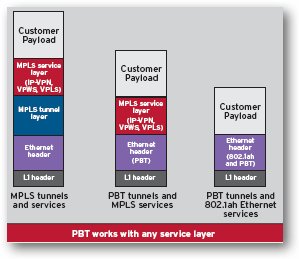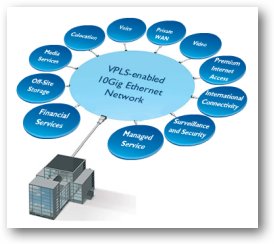Networks Part 7: Ethernet goes carrier grade?
March 2007
 (Picture credit: Nortel) Alongside IP,
Ethernet was always one of the 'chosen' protocols as it dominated enterprise Local Area Networks Network (LANs). I didn't
actually write about Ethernet back in the early 1990s because, at the time, it did not have a role in the Wide Area Network (WAN) space as a public data service protocol.
(Picture credit: Nortel) Alongside IP,
Ethernet was always one of the 'chosen' protocols as it dominated enterprise Local Area Networks Network (LANs). I didn't
actually write about Ethernet back in the early 1990s because, at the time, it did not have a role in the Wide Area Network (WAN) space as a public data service protocol.
As I mentioned in my post - The demise of ATM, it was assumed by many in the mid-1990s that Ethernet had reached the end of its life (NOT by users of Ethernet I might add!) and that ATM was the strategic direction for LAN protocols. This was so much assumed by the equipment vendor industry, that they spent vast amounts of money building ATM divisions to supply this perceived burgeoning market. But, this was just not to be.
The principle reason for this was that the ATM activists failed to understand that attempting to displace a well-understood and trusted technology with an unknown and new variety was a challenge too far. Moreover, ATM was so different that it would have required a complete replacement of not only 100% of LAN related network equipment but much of the personal computer hardware and software as well.
What was ATM supposed to bring to the LAN community? A promise of complete compatibility between LANs and WANs and an increase in the speed of IEEE 802.3 10mbit/s LAN backbones that was so desperately needed at the time.
ATM and Ethernet battled it out in the LAN public arena for only a short time as it was such a one sided battle. With the arrival of the 100mbit/s standard 100 BASE-T Ethernet standard, the Keep It Simple Stupid (KISS) approach gained dominance in the minds of users yet again. Why would you throw out years of investment for a promise of ATM jam tomorrow? Upgrading Ethernet LAN backbones to 100mbit/s was so simple as it only necessitated swapping out LAN interface cards and upgrading to better coaxial cable. Most importantly, there was no major requirements to update network software or applications. It was so much a non-brainer that it is now hard to see why ATM was ever thought to be the path forward.
This enigma lives on today and is it caused by the difference in views between the private and the public network industries. ATM came out of the public WAN network word, whereas IP and Ethernet came out of the private LAN world. Chalk and cheese in reality.
Once the dust had settled on the battles between ATM and Ethernet in the LAN market, the battle moved to the telecommunications WAN space and into the telco's home territory.
Ethernet moves into the WAN space
 I first heard about Ethernet being proposed as a wide
area protocol in mid-1990s when I visited Nortel's R&D labs in Canada. It was one of those moments I still remember quite well. It was in a small back room. I don't remember any equipment being on
display but if I remember correctly, all that was being shown were some blown-up diagrams of a proposed public Ethernet architecture. Now I would not claim that Nortel invented the idea of
Ethernet's use in the public sphere as I'm sure that if I had visited 3COM's R/D centre (the home of Ethernet) or other vendorss labs, I would have seen similar ideas being articulated.
I first heard about Ethernet being proposed as a wide
area protocol in mid-1990s when I visited Nortel's R&D labs in Canada. It was one of those moments I still remember quite well. It was in a small back room. I don't remember any equipment being on
display but if I remember correctly, all that was being shown were some blown-up diagrams of a proposed public Ethernet architecture. Now I would not claim that Nortel invented the idea of
Ethernet's use in the public sphere as I'm sure that if I had visited 3COM's R/D centre (the home of Ethernet) or other vendorss labs, I would have seen similar ideas being articulated.
The thought of Ethernet being used in WANs had not occurred to me before that moment and it really made me sit back and think (maybe I should have acted!). However, if Ethernet is ever going to be a credible wide area layer-2 network transport protocol it needs to be able to transparently transport any of the major protocols used in a converged network. This capability is provided in IP through the use of pseudowires and MPLS. This is where PBB-TE comes to the fore.
Over the next few years a whole new sector of the telecommunications industry started; this was termed Metropolitan Access Networks (MANs) or more simply Metro Networks. In the latter half of the 1990s - the heyday of carrier start-ups - many new telcos were set up using a new architecture paradigm based on Ethernet over optical fibre. The idea was that metro networks would sit between enterprise networks and traditional wide-area telco networks. Metro networks would inter-connect enterprise offices at the city level, aggregate data traffic that needs to be transported long distances and deliver it to telcos who could ship that traffic as required to other cities or countries using frame relay services.
Many of these metro players ceased trading during the recent challenging years but many were refinanced and were resurrected to live again.
 (Picture credit: exponential-e) It is
very interesting to note that throughout that phase of the industry and even up to today, Ethernet has not gained the full acceptance as a viable public service protocol from the wider
telecommunications industry. Until a few years ago, outside of specialist metro players, very few traditional carriers offered wide offered Ethernet services at all. This was quite amazing when
it is considered that it flew in the face of strong requests from enterprises who all wanted them. What turned this round to a degree was the deployment of MPLS backbones by carriers who could
then offer Ethernet as an access protocol to enterprises but handle Ethernet services on their network through an MPLS tunnel.
(Picture credit: exponential-e) It is
very interesting to note that throughout that phase of the industry and even up to today, Ethernet has not gained the full acceptance as a viable public service protocol from the wider
telecommunications industry. Until a few years ago, outside of specialist metro players, very few traditional carriers offered wide offered Ethernet services at all. This was quite amazing when
it is considered that it flew in the face of strong requests from enterprises who all wanted them. What turned this round to a degree was the deployment of MPLS backbones by carriers who could
then offer Ethernet as an access protocol to enterprises but handle Ethernet services on their network through an MPLS tunnel.
Bringing ourselves up to the present time, traditional carriers are starting to offer layer-2 Ethernet-based Virtual Private Networks (VPNs) in parallel to their offerings of layer-3 MPLS-based IP-VPNs. One of the interesting companies that focused on Ethernet in the UK is exponential-e who I will be writing about soon
The wide area protocol battle restarts
What is of overt interest today, is the still open issue of Ethernet over fibre being a real alternative to a core architecture based on MPLS. It could be said that this battle is in the process of really starting today but it has been very slow in coming. Ethernet LAN <-> Ethernet WAN <-> Ethernet LAN would seem to be a natural and simple option.
Ethernet is dominant in carrier's customers LAN networks, Ethernet is dominant in the metro networks, but Ethernet has had little impact in WAN networks. Partially, this is to do with technology politics and a distinct reluctance of traditional carriers to offer Ethernet services (in spite of insistent siren calls from their customers). It could be said that the IP and MPLS bandwagon has taken all the money, time and strategy efforts of the telcos leaving Ethernet in the wings.
 It should be said that this also has to do with the
technical challenges associated with delivering Ethernet services over longer distances than those seen in metro networks. This is where a new initiative called Provider Backbone
Transport (PBT) comes into play which could provide a real alternative to the almost-by-default-use-of-MPLS core strategy of most of the traditional carriers. Interestingly, reminding
me of my visit to Canada, Nortel along
with Siemens are one of the key players in this market. Here is an interesting presentation
Highly Scalable Ethernets
by Paul Bottorff, Chief Architect, Carrier Ethernet, Nortel.
It should be said that this also has to do with the
technical challenges associated with delivering Ethernet services over longer distances than those seen in metro networks. This is where a new initiative called Provider Backbone
Transport (PBT) comes into play which could provide a real alternative to the almost-by-default-use-of-MPLS core strategy of most of the traditional carriers. Interestingly, reminding
me of my visit to Canada, Nortel along
with Siemens are one of the key players in this market. Here is an interesting presentation
Highly Scalable Ethernets
by Paul Bottorff, Chief Architect, Carrier Ethernet, Nortel.
PBT is a group of enhancements to Ethernet that are defined in the IEEE's Provider Backbone Bridging Traffic Engineering (PBBTE) - phew, that's a mouthful.
PBBTE is all about separating the Ethernet service layer from the network layer thus enabling the development carrier-grade public Ethernet services such as outlined by Nortel:
- Traffic engineering and hard QoS: Provider Backbone transport enables service provider's to traffic engineer their Ethernet networks. PBT tunnels reserve appropriate bandwidth and support the provisioned QoS metrics that guarantee SLAs will be met without having to overprovision network capacity.
- Flexible range of service options: PBT supports multiplexing of any service inside PBT tunnels - including both Ethernet and MPLS services. This flexibility allows service providers to deliver native Ethernet initially and MPLS-based services (VPWS, VPLS) if and when they require.
- Protection: PBT not only allows the service provider to provision a point-to-point Ethernet tunnel, but to provision an additional backup tunnel to provide resiliency. In combination with IEEE 802.1ag these working and protection paths enable PBT to provide sub 50 ms recovery.
- Scalability: By turning off MAC learning features we remove the undesirable broadcast functionality that creates MAC flooding and limits the size of the network. Additionally PBT offers a full 60-bit addressing scheme that enables virtually limitless numbers of tunnels to be set-up in the service provider network.
- Service management: Because each packet is self identifying, the network knows both the source and destination address in addition to the route - enabling a enables more effective alarm correlation, service-fault correlation and service-performance correlation.
Ethernet has a long 30-year history since it was invented by Robert Metcalfe in the early 1970s. It went on to dominate enterprise networking and intra-city local networking and only wide area networks are holding out. MPLS has taken centre-stage as the ATM replacement technology providing the level of Quality of Service (QoS) needed by today's multimedia services. But MPLS is expensive and challenging to operate on a large scale and maybe Ethernet can catch it up with the long-overdue enhancements brought about by PBBTE.
In Where now frame relay? I talked about how frame relay took off once X.25 was cleared of its cumbersome overheads that made it expensive to use as a wide area protocol. PBB-TE / PBT could achieve a similar result for Ethernet. Maybe this initiative will clear the current log jam that will enable Ethernet to take up its rightful position in the public service space along side MPLS. The battle could be far from over!
The big benefit at the end of the day is that PBB-TE is a layer-2 technology, so a carrier deploying it would not need to buy additional layer-3 infrastructure and OSS in the form of routers and MPLS thu, hopefully, representing a significant cost saving for roll-out.
Addendum: BT have recently committed to deploy Nortel's PBT technology (presentation). As can be read in the Light Reading analysis:
[BT] is keen to play down any PBT versus MPLS positioning. He says the deployment at BT shows how PBT and MPLS can co-exist. "It's not a case of PBT versus MPLS. PBT will be deployed in the metro core and interface back into BT's MPLS backbone network."
It's quite easy to understand why BT would want to say this!
 Addendum: One of the
principle industry groups promoting and supporting carrier grade Ethernet is the Metro Ethernet Forum (MEF) and in 2006 they
introduced their official certification programme. The certification is currently only availably to
MEF members - both equipment manufacturers and carriers - to certify that their products comply with the MEF's carrier Ethernet technical specifications. There are two levels of
certification:
Addendum: One of the
principle industry groups promoting and supporting carrier grade Ethernet is the Metro Ethernet Forum (MEF) and in 2006 they
introduced their official certification programme. The certification is currently only availably to
MEF members - both equipment manufacturers and carriers - to certify that their products comply with the MEF's carrier Ethernet technical specifications. There are two levels of
certification:
MEF 9 is a service-oriented test specification that tests conformance of Ethernet Services at the UNI inter-connect where the Subscriber and Service Provider networks meet. This represents a good safeguard for customers that the Ethernet service they are going to buy will work! Presentation or High bandwidth stream overview
MEF 14: Is a new level of certification that looks at Hard QoS which is a very important aspect of service delivery not covered in MEF 9. MEF 14 provides a hard QoS backed by Service Level Specifications for Carrier Ethernet Services and hard QoS guarantees on Carrier Ethernet business services to their corporate customers and guarantees for triple play data/voice/video services for carriers. Presentation.
Addendum: A competitor to PBT / PBB-TE is TMPLS - see my post
